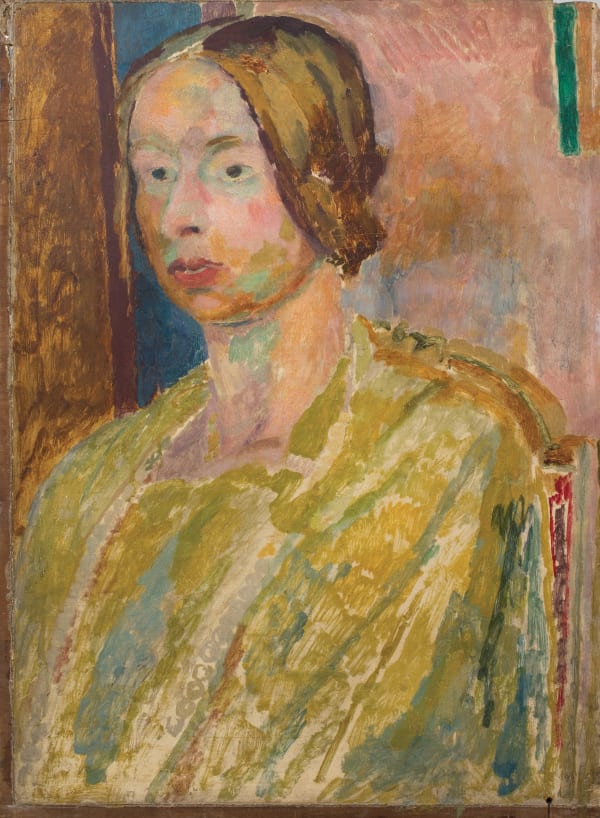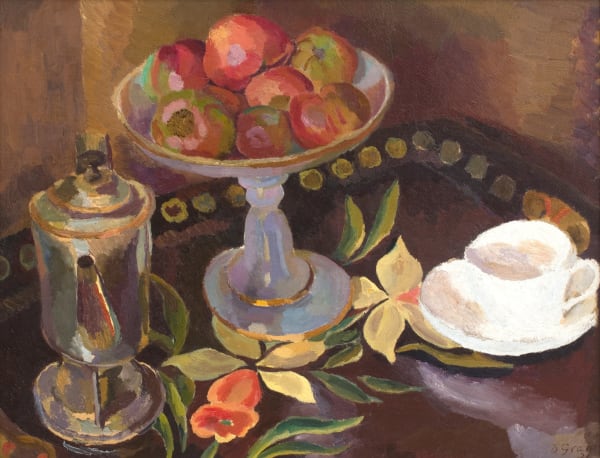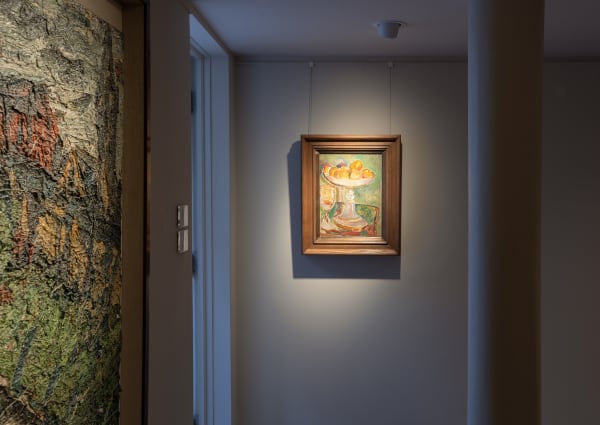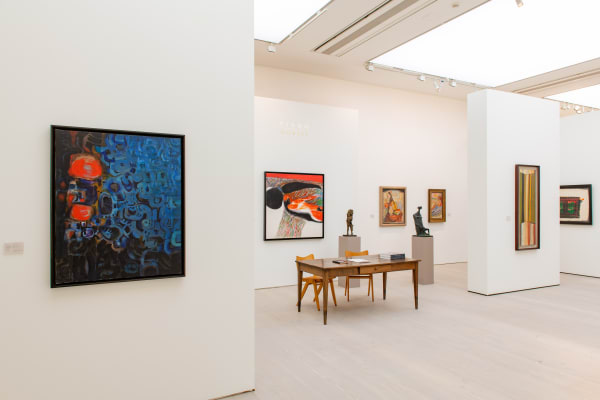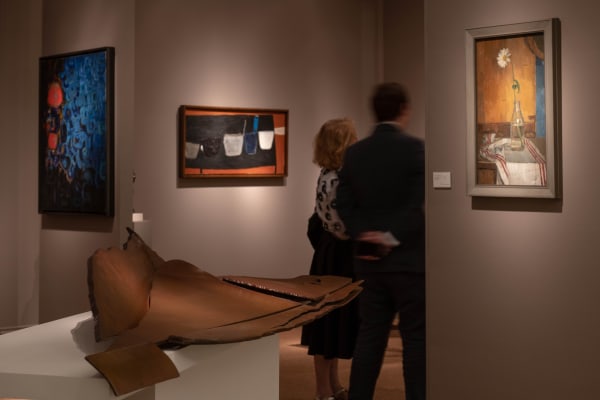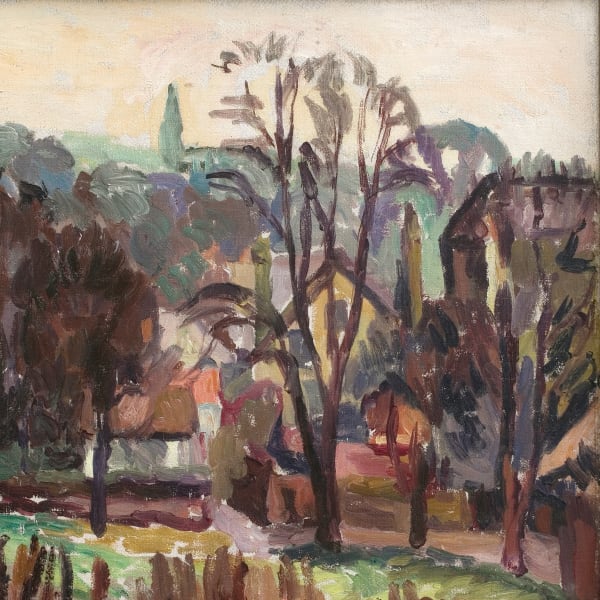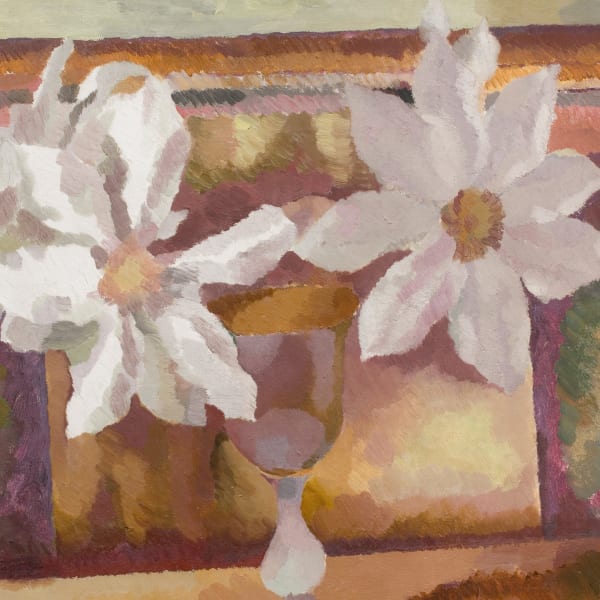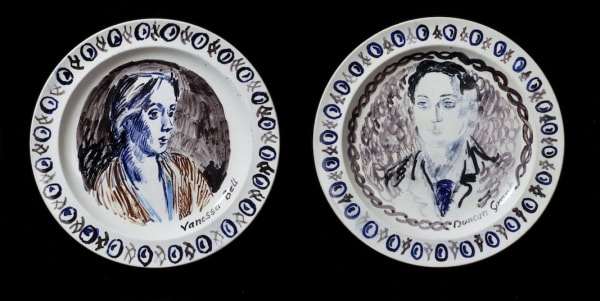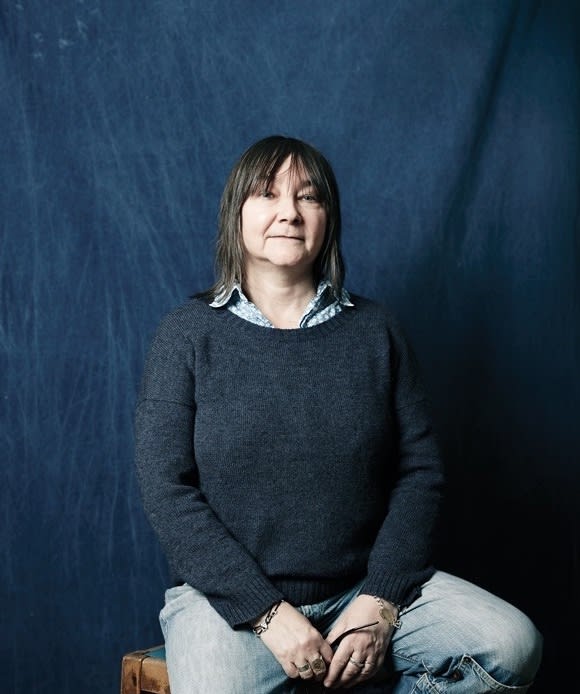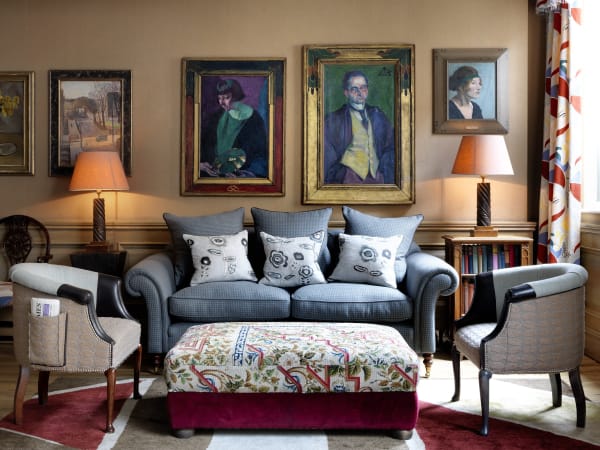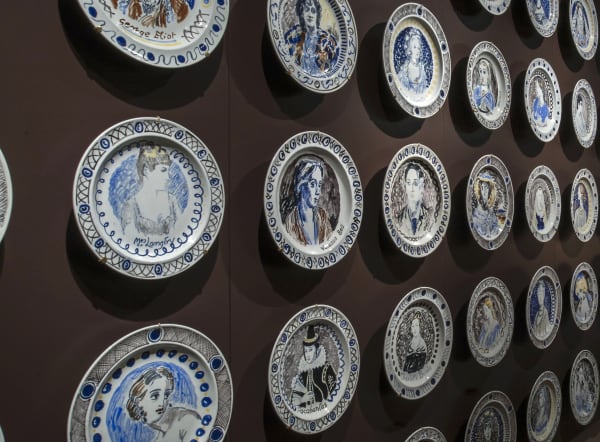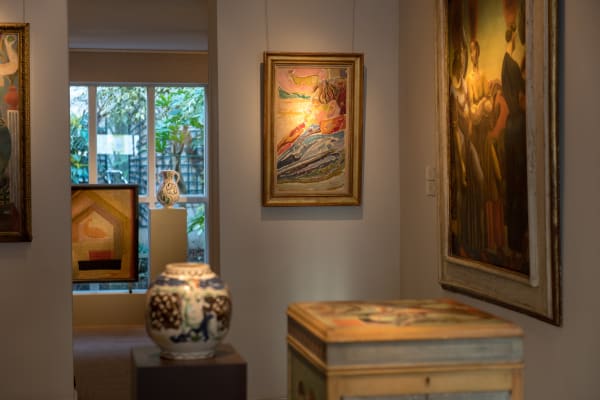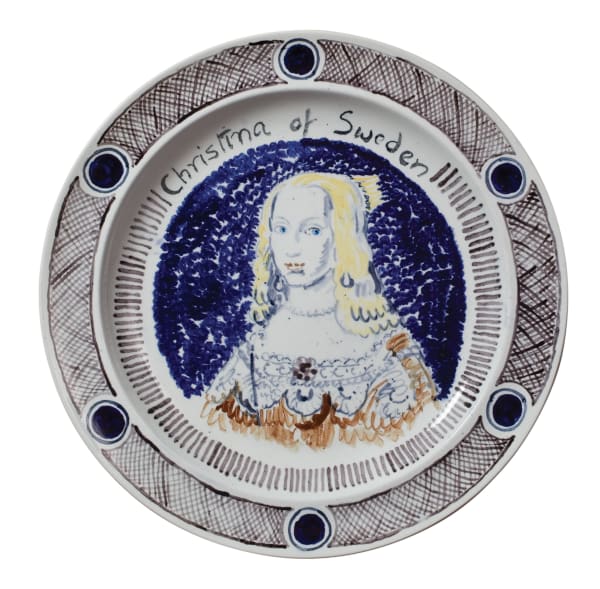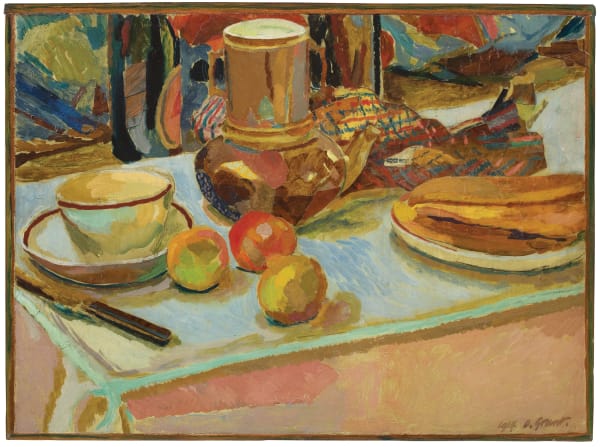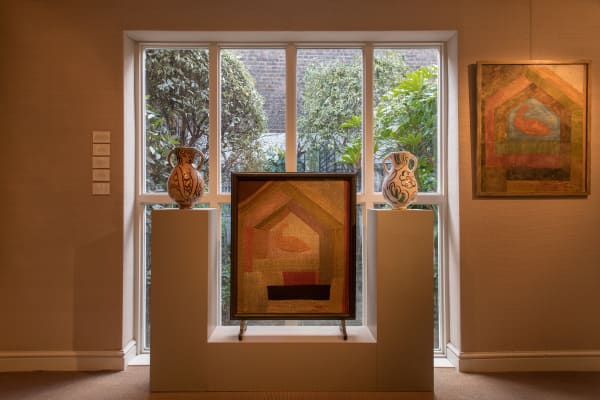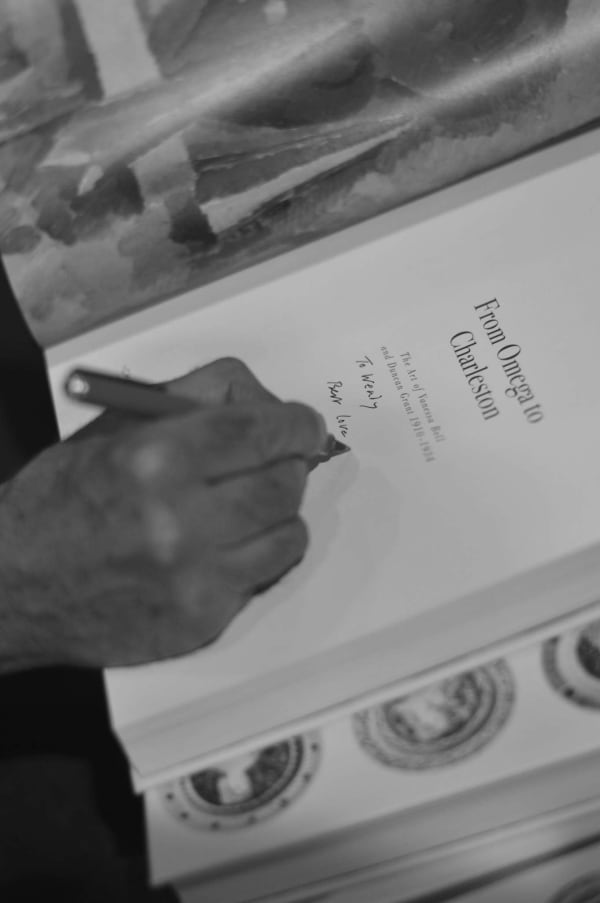Duncan Grant
The gallery regularly handles, acquires and advises on works by Duncan Grant. For more information or the availability of work, please contact the gallery.
Duncan Grant (1885–1978)
Duncan Grant was born in 1885 in Inverness-shire, Scotland. Grant was a Post-Impressionist painter and designer best known for his bold use of colour and form and being a central figure in the Bloomsbury Group. He was born into a military family, his father was a Major in the British army with postings in India and Burma. Grant went on to study at Westminster School of Art between 1902-1907. In 1906 Grant travelled in Italy and France where he studied under the tutelage of Jacques-Èmile Blanche. In 1909, Grant moved to Fitzroy Square on the outskirts of Bloomsbury which was becoming a meeting point for artists, critics and writers. He shared the flat with cousin and lover John Maynard Keynes and through this relationship was introduced to Virginia Stephen (later Woolf) and Vanessa Bell, among others.
In 1911 he joined the controversial and equally prestigious Camden Town Group and a year later, exhibited works in the now famous Second Post-Impressionist exhibition, curated by Roger Fry, next to works by Paul Gaugin, Vincent Van Gogh and Henri Matisse. In 1913, alongside Fry and Bell, Grant was a co-Director of the design cooperative the Omega Workshops. In 1914, at the outbreak of the First World War, Grant became a conscientious objector moving with his two lovers, Vanessa Bell and David Garnett, to Suffolk and later to the farmhouse Charleston in Sussex which is now characterised by its bold, hand-painted interior worked by both artists. Throughout his long career Grant was a member of a wide range of artistic groups such as the Grafton Group, the New English Art Club and the Vorticists, led by Percy Wyndham Lewis. He had his first solo show in 1920 held at the Carfax Gallery and went on to represent Great Britain at the Venice Biennale in 1926 and 1932. In the 1940s and early 1950s work by the Bloomsbury Group fell out of popularity. However, in the 1960s Grant’s work gained a new surge of interest which resulted in a retrospective of his work held at the Tate Gallery in 1964 and two solo shows at the Anthony d’Offay Gallery in 1972 and 1975.
After living alone at Charleston for many years, Grant moved in with his close friend and long-time friend Paul Roche in Almaston where he died in 1978.
-
 Still Life with Decanter, 1917, c.
Still Life with Decanter, 1917, c. -
 Self-Portrait in Hat, 1909 c.
Self-Portrait in Hat, 1909 c. -
 Portrait of Mary Hutchinson, 1915
Portrait of Mary Hutchinson, 1915 -
 Portrait of Vanessa Bell (The Red Hat), 1917, c.
Portrait of Vanessa Bell (The Red Hat), 1917, c. -
 Still Life, 1917–18, c.
Still Life, 1917–18, c. -
 David 'Bunny' Garnett Smoking a Pipe, 1918, c.
David 'Bunny' Garnett Smoking a Pipe, 1918, c. -
 Still Life with Fruit and Compotier, 1919–20, c.
Still Life with Fruit and Compotier, 1919–20, c. -
 Angus Davidson at Charleston, 1923-28, c.
Angus Davidson at Charleston, 1923-28, c. -
 Still life with Fruit and Coffee-pot, 1914
Still life with Fruit and Coffee-pot, 1914
-
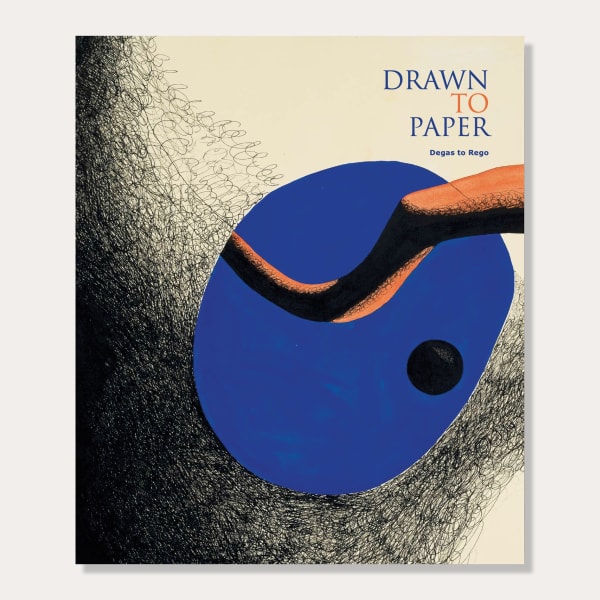
Drawn to Paper
Degas to Rego Piano Nobile, 2020softback, 40 pagesRead more
Publisher: Piano Nobile Publications
ISBN: 978-1-901192-58-2
Dimensions: 28 x 24cm -
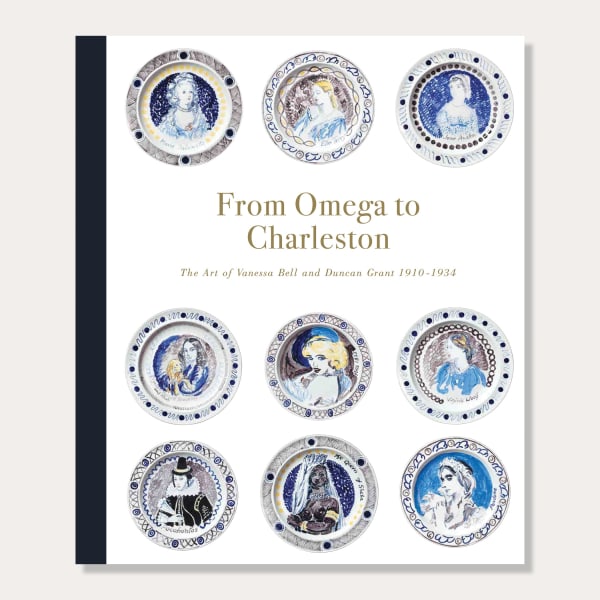
From Omega To Charleston
The Art of Vanessa Bell and Duncan Grant 1910 - 1934 Richard Shone and Hana Leaper, 2018Hardback, 256 pagesRead more
Publisher: Piano Nobile Publications
ISBN: 9781901192513
Dimensions: 29 x 24 x 5 cm -
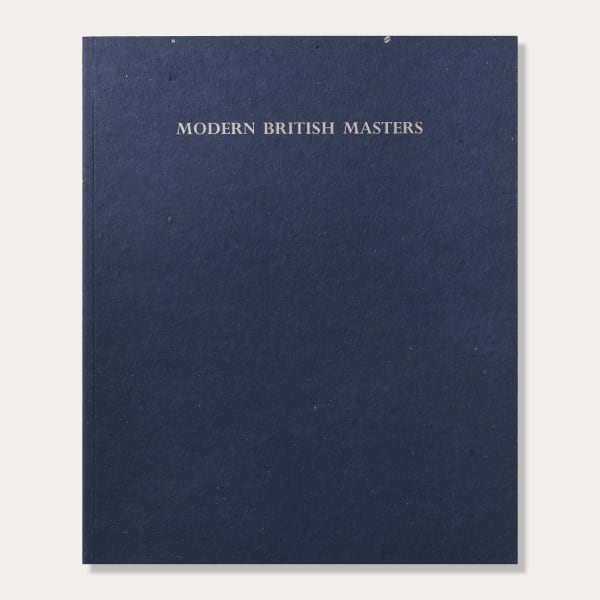
Modern British Masters
Paintings and Sculptures Dr Robert Travers, 1995Softback, 40 pagesRead more
Publisher: Piano Nobile Publications
Dimensions: 29 x 34 x 0.5 -

Modern British Masters
Dr Robert Travers, 1994Softback, 34 pagesRead more
Publisher: Piano Nobile Publications
Dimensions: 29 x 34 x 0.5 cm
-

Treasure House Fair
Royal Hospital Chelsea 27 Jun - 2 Jul 2024 Art FairPiano Nobile returned to The Treasure House Fair in June of 2024. We highlighted works from across the twentieth century, with early paintings by Augustus John and Walter Sickert, Duncan...Read more -

Treasure House Fair
Royal Hospital Chelsea 22 - 26 Jun 2023 Art FairThe Treasure House Fair is a celebration of outstanding and rare art and antiques. Held at The Royal Hospital Chelsea the fair continues the tradition of its predecessors, Masterpiece and...Read more -

A Celebration of Portraiture
Twentieth-Century Britain 5 Jun - 31 Jul 2023 Piano NobileA Celebration of PortraitureRead more
Portraits from Twentieth-Century Britain
An exhibition in collaboration with the National Portrait Gallery
-

Bloomsbury Portraits
Virtual Vortic Gallery 3 - 30 Sep 2021 OnlineBloomsbury is a small area of London, bracketed to the north by Euston Road and to the south by New Oxford Street. For a few decades in the early twentieth...Read more -

London Art Week
Summer 2021 2 - 16 Jul 2021 Piano NobileFor London Art Week 2021, Piano Nobile presented an online display of paintings, sculpture and works on paper. Featured artists included Walter Sickert, Eric Gill, Alexander Calder and Frank Auerbach....Read more -

Drawn to Paper
Calder to Scott 2 Jul - 6 Aug 2021Paper is easily and variously marked. Charcoal and chalk scuff, smudge or slice; pen and ink dash, hatch and stipple; areas of colour shimmer in pastel, glow in gouache or...Read more -

Defining British Art
1910 - 2000 17 May - 23 Jul 2021 Piano NobileThis exhibition reviewed the major creative outbursts in twentieth-century Britain, with paintings, sculptures, ceramics and textiles made by four generations of pioneering artists – from Sickert at the fin de...Read more -

Drawn to Paper
Degas to Rego 24 Jun - 24 Jul 2020In 2020 Piano Nobile presented Drawn to Paper: Degas to Rego , an online exhibition which showcased works on paper by some of the leading figures of European modernism. The...Read more -

British Art Fair
Saatchi Gallery 20 - 23 Sep 2018 Art FairPiano Nobile presented a selection of Post-War and Modern British art, including works by Craigie Aitchison, Kenneth Armitage, David Bomberg, Peter Coker, William Crozier, Leslie Marr, Leon Kossoff, Paul Nash,...Read more -

Masterpiece
Royal Hospital Chelsea 28 Jun - 4 Jul 2018 Art FairPiano Nobile presented a selection of Modern and Contemporary British and International artists including works by Anthony Caro, Leon Kossoff, Euan Uglow, Paul Nash, Mark Gertler, William Crozier, Craigie Aitchison...Read more -

Modern British Masters (III)
Selected Highlights 29 May - 20 Jun 2018 Piano NobileContinuing a series of exhibitions on the theme, Piano Nobile presented a display of Modern British Masters. Stretching from the birth of modern art at the beginning of the twentieth...Read more -

From Omega to Charleston
The Art of Vanessa Bell and Duncan Grant 1910 -1934 16 Feb - 28 Apr 2018 Piano NobileIn 2018 Piano Nobile staged From Omega to Charleston: The Art of Vanessa Bell and Duncan Grant, 1910-1934 , an exhibition of painting and applied art by two of the...Read more -

Masterpiece
Royal Hospital Chelsea 27 Jun - 5 Jul 2017 Art FairThe gallery presented a selection of Modern and Contemporary British and International artists including works by William Scott, Tracey Emin, Lucian Freud, Augustus John, Duncan Grant and Vanessa Bell, Eduardo...Read more
-

InSight No. 153
Duncan Grant | Hampstead Heath July 19, 2024A rural patch north of London has provided more than one English painter with rich material to make landscape into art. InSight No. 153 Duncan...Read more -

InSight No. 141
Duncan Grant | Still Life January 12, 2024Duncan Grant’s early still-life pictures contributed to a new universe of creativity that skilfully brought together easel painting, decorative objects and interior design. InSight No....Read more -

InSight No. 128
Duncan Grant | Still Life with Fruit and Compotier June 30, 2023Long before the era of paper cups and over-the-counter service, Duncan Grant and Henri Matisse savoured the civilising effects of the coffee ritual. InSight No....Read more -

Bloomsbury Now Symposium
St Peter's College Oxford November 8, 2022On Saturday 12 November, Piano Nobile’s researcher Luke Farey will be contributing a short paper to a symposium about the Bloomsbury Group held at St...Read more -

InSight No. 103
Duncan Grant | Portrait of Simon Bussy, circa 1922-25 May 26, 2022A man of good ties and a painter of curiously vivid pictures, Simon Bussy was one of the few truly French nodes in the Bloomsbury...Read more -

When does a fabric swatch fetch £8,750? When it’s by Omega Workshops
The Financial Times September 25, 2020Robert Travers was interviewed for an article in The Financial Time s about the prices fetched by Bloomsbury Group artists. Their reach is increasingly global....Read more -

InSight No. 17
Vanessa Bell and Duncan Grant | The Famous Women Dinner Service June 4, 2020For this final focus on the art of Duncan Grant and Vanessa Bell, InSight recalls the story of the Famous Women Dinner Service – a...Read more -

InSight No. 15
Duncan Grant | David 'Bunny' Garnett Smoking a Pipe May 27, 2020To celebrate the beginning of summer, InSight is dedicating three articles to works by Vanessa Bell and Duncan Grant. In another special edition, Richard Shone...Read more -

Robert Travers and Ali Smith interviewed for BBC Front Row
Kirsty Lang May 17, 2018BBC Radio 4 Front Row have interviewed Robert Travers and Ali Smith about The Famous Women Dinner Service a work of 50 ceramic plates featuring...Read more -

Designing Bloomsbury | Kit Kemp in conversation with Matthew Travers
April 3, 2018Wednesday 11 April 2018 The Drawing Room at Charlotte Street Hotel, 15 Charlotte Street, London, W1T 1RJ Piano Nobile is pleased to offer first access...Read more -

House & Garden review From Omega to Charleston
Virginia Clark April 2, 2018House & Garden have published an extensive review of Piano Nobile's most recent exhibtion 'From Omega to Charleston: The Art of Vanessa Bell and Duncan...Read more -

Artnet News features The Famous Women Dinner Service
April 2, 2018'Decades Before Judy Chicago’s ‘The Dinner Party,’ Virginia Woolf’s Sister Made a Set of Dinner Plates Celebrating 50 Historic Women ' Artnet news have featured...Read more -

Apollo features Piano Nobile
Florence Hallett March 19, 2018Apollo Online has reviewed the exhibition From Omega to Charleston: The Art of Vanessa Bell and Duncan Grant 1910 - 1934 at Piano Nobile. Titled...Read more -

From Omega to Charleston in The Daily Telegraph
Colin Gleadell March 4, 2018The Daily Telegraph has published a comprehensive write up by Colin Gleadell in the Art Market Focus of From Omega to Charleston: The Art of...Read more -

Another Magazine discusses The Famous Women Dinner Service
Harriet Barker March 3, 2018Another Magazine has featured the exhibition From Omega to Charleston: The Art of Vanessa Bell and Duncan Grant 1910 - 1934 in their online Art...Read more -

Piano Nobile exhibition features in The Week
London March 3, 2018From Omega to Charleston: The Art of Vanessa Bell and Duncan Grant 1910 - 1934 has been chosen as the feature in the 'Where to...Read more -

From Omega to Charleston in Country Life
Huon Mallalieu March 2, 2018Piano Nobile's exhibition From Omega to Charleston: The Art of Vanessa Bell and Duncan Grant 1910 - 1934 has been featured as the 'Pick of...Read more -

Book Launch | Hatchards Piccadilly
London February 1, 2018WEDNESDAY 14 MARCH 2018 Hatchards Piccadilly 187 Piccadilly, London, W1J 9LE Panel Discussion, 5pm* | Book Launch, 6 - 8.30pm *Limited Capacity, please RSVP for...Read more -

Bloomsbury, Bloodshed and the Bible with Julian Fellowes
Royal Institution, London February 1, 2018THURSDAY 12 APRIL 2018 Royal Institution, 21 Albermarle Street, London W1S 4BS 7 - 9pm The programme will begin with actor, novelist, film director and...Read more







